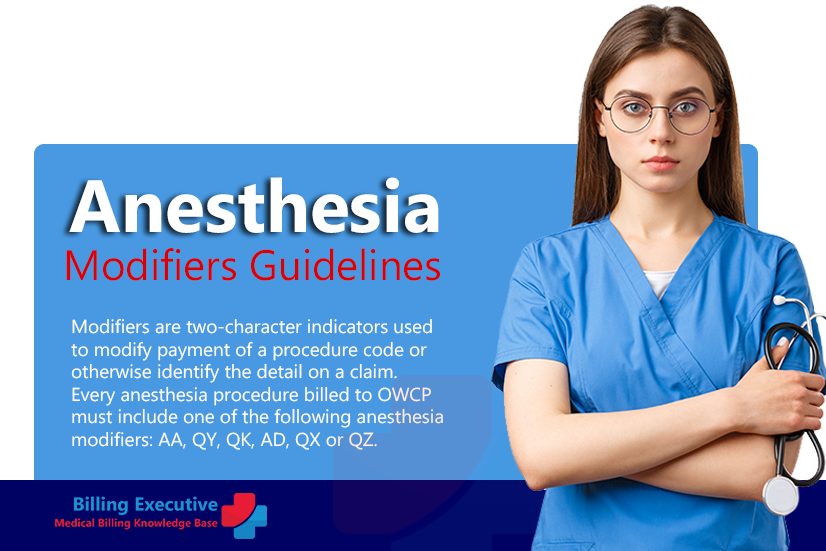Getting the details right for anesthesia billing and coding is crucial, as it plays an essential role in all medical coding and billing. Selecting the appropriate modifiers, accurately indicating the patient’s physical status, and recording any other qualifying circumstances are equally important. Documentation, start and end times, and code selection are essential to how claims are paid.

Whether you are new to anesthesia coding and billing or an expert, this article will refresh your memory on anesthesia modifiers, physical status, and qualifying situational factors.
Modifiers for Anesthesia P1-P6
All anesthesia facilities are observed using the five-digit anesthesia procedure code (00100-01999) and a physical status modifier. Other additional modifiers could be used if required.
Modifiers of Physical Status
Physical Status modifiers are denoted by the letter ‘P’ followed by a single digit ranging from 1 to 6 as defined below:
P1 – A healthy regular patient.
P2 – A patient suffering from mild systemic disease.
P3 – A patient suffering from severe systemic illness.
P4 – A patient suffering from a severe systemic disease that causes a constant threat to life.
P5 – An unconscious patient who is doubtful without the operation.
P6 – A brain-dead patient whose organs are being harvested for donation
The six levels listed above correspond to the American Society of Anesthesiologists (ASA) classification of patient physical status. CPT includes a physical position to differentiate between the numerous layers of difficulty of the anesthesia service provided.
Guidelines for Anesthesia Billing Aspects
Prior Authorization
Prior authorization is not needed for anaesthesia; however, prior approval may be required by the connected surgical procedure or service.
Time-based units
Fifteen minutes’ equals 1 unit during the first 4 hours of service. If services are available for more than 4 hours in a single session, each 10-minute period after the first 4 hours equals 1 unit. A less than a unit period should be rounded up to the nearest unit.
Qualify circumstances
Qualifying circumstances are charged using add-on codes instead of modifiers, listed separately alongside the anesthesia code. Among them are the following codes:
99100 – Anesthesia for patients between the ages of one and seventy (1 unit)
99116 – Anesthesia is made more difficult by the use of total body hypothermia (5 units)
99135 – Anesthesia is made more difficult by the use of controlled hypotension (5 units)
99140 – Anesthesia is made more difficult by emergency conditions (2 units)
According to the ASA, it is not suitable to code 99100 for anesthesia codes chosen for pediatric patients. In addition, codes 99116 and 99135, associated with cardiac procedures done with cardiopulmonary bypass, should not be revealed when hypothermia or hypotension may occur as a consequence of being on bypass.
Subsequently, the emergency condition should be clarified when using 99140.
General, local, regional, and epidural anesthesia services are available
- We can not provide separate or supplemental reimbursement for the standard monitoring processes typically included in and recorded on the anesthesia record because they are regarded as an integrated component of anesthesia services and are included in the anesthesia base unit value. Unexpected monitoring methods (for example, intra-arterial, central venous, and Swan-Ganz) are not included and may be charged separately.
- Because local anesthesia is considered part of the surgical procedure or other manipulation for which it is administered, we can not provide wholly separate or extra reimbursement.
- CPT codes 99143-99145 should be used to report modest sedation services offered by the same doctor able to perform the diagnostic and therapeutic service that the sedation supports.
About us
Billing Executive – a Medical Billing and Coding Knowledge Base for Physicians, Office staff, Medical Billers and Coders, including resources pertaining to HCPCS Codes, CPT Codes, ICD-10 billing codes, Modifiers, POS Codes, Revenue Codes, Billing Errors, Denials and Rejections.
We have more than 10 years experience in US Medical Billing and hand-on experience in Web Management, SEO, Content Marketing & Business Development with Research as a special forte.
Learn More
What is Medical Billing? and what are the common steps in medical billing process?
How to use modifier 52 and claim submission guidelines?
Understand and Recognize the Types of CPT Codes 2022
How Much Does Healthcare RCM Services Cost in 2021?
